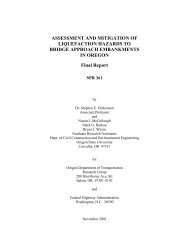Oregon Balance of State HIV/AIDS Housing & Services Systems ...
Oregon Balance of State HIV/AIDS Housing & Services Systems ...
Oregon Balance of State HIV/AIDS Housing & Services Systems ...
You also want an ePaper? Increase the reach of your titles
YUMPU automatically turns print PDFs into web optimized ePapers that Google loves.
<strong>Oregon</strong> <strong>HIV</strong>/<strong>AIDS</strong> <strong>Housing</strong> and <strong>Services</strong> <strong>Systems</strong> Integration Plan 33<br />
Coordinating services integration is a particular challenge in rural areas. The multi-county Eastern<br />
<strong>Oregon</strong> Human <strong>Services</strong> Consortium (EOHSC) is one potential venue for improving systems<br />
integration. The EOHSC is a cooperative body <strong>of</strong> community mental health programs that addresses<br />
the practicalities <strong>of</strong> delivering mental health, alcohol and drug treatment, and developmental<br />
disability services to the widespread communities <strong>of</strong> Eastern <strong>Oregon</strong>, and represents the region’s<br />
interests to the state legislature. EOHSC includes the counties <strong>of</strong> Gilliam, Grant, Harney, Hood<br />
River, Malheur, Morrow, Sherman, Umatilla, Union, Wallowa, Wasco, and Wheeler. 72<br />
Human <strong>Services</strong> and Public Assistance<br />
The most recent <strong>Oregon</strong> <strong>HIV</strong>/<strong>AIDS</strong> needs assessment estimated that two-thirds <strong>of</strong> people living<br />
with <strong>HIV</strong>/<strong>AIDS</strong> across the state have incomes below the federal poverty level. 73 People living with<br />
<strong>HIV</strong>/<strong>AIDS</strong> frequently have an array <strong>of</strong> basic needs that are common to low-income people in<br />
general, that also may be linked to their medical condition. These can include food and nutritional<br />
assistance, medical insurance, transportation, hygiene, family support, and general financial needs.<br />
Many clients rely on entitlement programs, including Supplemental Security Income (SSI) and<br />
Social Security Disability Insurance (SSDI), which are administered directly by the federal<br />
government, and provide income support for people with disabilities. Clients may also seek and<br />
receive assistance from faith-based or other private relief organizations, which comprise an<br />
important part <strong>of</strong> the “safety net” in many communities.<br />
While mainstream public assistance and human service programs sometimes meet the needs <strong>of</strong><br />
people living with <strong>HIV</strong>/<strong>AIDS</strong> as they are, this population sometimes needs enhanced assistance. For<br />
example, some <strong>HIV</strong>/<strong>AIDS</strong> medications require high-calorie diets, and consumers with low incomes<br />
<strong>of</strong>ten need assistance purchasing food and designing well-balanced diets that meet those<br />
requirements.<br />
In the survey <strong>of</strong> service providers for this needs assessment, while 81 percent <strong>of</strong> respondents from<br />
<strong>HIV</strong>/<strong>AIDS</strong> agencies said that they had partnerships for food assistance, half <strong>of</strong> all respondents said<br />
that food and nutritional assistance was insufficient in their region. Fifty-six percent felt that<br />
increasing access to mainstream services such as food stamps and SSI/SSDI was one <strong>of</strong> the highest<br />
priorities for systems integration.<br />
The primary resources for meeting human services and general assistance needs (beyond what is<br />
covered by federal disability entitlements for those who qualify) tend to be state and local public<br />
assistance programs – historically known as welfare. The largest <strong>of</strong> these programs, Temporary Aid<br />
to Needy Families (TANF) and food stamps, are federally funded but administered by state agencies<br />
– in <strong>Oregon</strong>, by the Department <strong>of</strong> Human <strong>Services</strong> (DHS) Children, Adults and Families<br />
(CAF) Division. DHS also administers (through its Division <strong>of</strong> Medical Assistance Programs) the<br />
<strong>Oregon</strong> Health Plan, the state’s vehicle for administering Medicaid and other health funds, which<br />
may cover some basic services. Integration efforts among these programs has historically taken<br />
place at the level <strong>of</strong> state administrators, but integrated strategies must be reinforced at the local<br />
72<br />
Eastern <strong>Oregon</strong> Human <strong>Services</strong> Consortium. Available online: http://www.eoddr.com/aboutEohsc.html (Accessed: November 30,<br />
2007).<br />
73<br />
<strong>Oregon</strong> Department <strong>of</strong> Human <strong>Services</strong>, Program Design and Evaluation <strong>Services</strong>. We Listened…2005: Survey for People Living<br />
with <strong>HIV</strong> and <strong>AIDS</strong> in <strong>Oregon</strong>. Available online: http://www.oregon.gov/DHS/ph/hiv/services/needs/reports.shtml (Accessed:<br />
November 27, 2007).

















